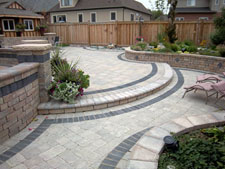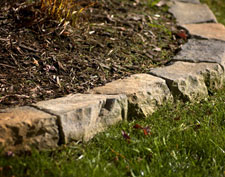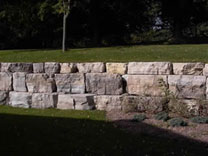4 Best Retaining Wall Materials & Things To Consider

Why is Wall Height Important?
Retaining walls are designed to hold back soil and earth. The taller they are, the stronger they need to be. Soil, particularly wet soil, will exert pressure on the back of the wall. For low retaining walls, approximately two feet tall or less, there are many options for wall materials. Once the wall height reaches the two to three-foot range, look at retaining wall blocks that are specifically engineered for more demanding situations.
1. Low Retaining Wall Materials

Want to learn more about the best materials for your retaining walls? Give our team at Grand River Natural Stone a call today.
2. Medium Height Retaining Walls
For walls that are two and a half feet or taller, it is best to use an interlocking retaining wall block or armour stone. Interlocking wall blocks have grooves and beads that keep the blocks in place, protecting against shifting due to soil pressure. There are several manufacturers that make this type of product. You can choose from a variety of styles and colours. The blocks are designed to make installation relatively easy.
Armour stone also works well for medium to tall walls. Most armour stone is approximately 20-30 inches high by 24-36 inches deep and 2 or more feet in length. Its large size makes it a good option for a medium to tall retaining wall with beautiful, natural-looking results.
3. Tall Retaining Walls

Additional Materials for Retaining Wall Construction
As with other types of landscape construction, the parts of retaining walls you don’t see are crucial to the success of the final product. Retaining walls should be built on a compacted base of drainage stone or clear stone. The stone layer is usually 10 – 12 inches deep; taller walls need more stone. This reduces the amount of water pressure on the wall. Perforated drain pipe should be added as part of this base construction, behind and below the wall to carry water away.
Due to the size and weight of retaining wall blocks and stone, site access is an important consideration. Interlocking wall units are somewhat easier to move than large natural stone and armour stone. If you have a backyard that heavy machinery cannot get to, interlocking units may be your best choice.
Regardless of your site conditions and design style preference, there are numerous retaining wall materials to choose from. Talk to your landscape supplier and visit their display yard to see your options in person. It’s the first step in making a long-lasting, functional and attractive improvement to your home landscape.